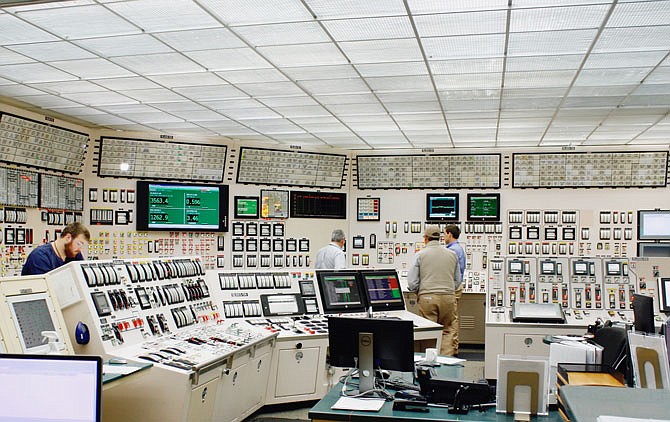As 2019 winds down, the Callaway Energy Center is celebrating 35 years of operation.
The nuclear power plant became operational in 1984 and Anne Roselius, manager of communications at Ameren, said the plant's anniversary date is a bit disputed by employees. While the first nuclear chain reaction took place Oct. 2, 1984, the plant was not declared "fully operational" until Dec. 19, 1984.
"I brought it up the other day to some of our senior leaders and they got into this debate about which is the official date, so I decided we're just going to celebrate them all," Roselius said.
Mark McLachlan, senior director of plant support, explained how the plant has become much more efficient in its history.
"The plant has absolutely become more efficient with our new steam generators, new turbine and generator rewinds," McLachlan said.
He said a steam cycle can only become so efficient at the plant before physics begin to kick in. The plant currently operates at 34-35 percent efficiency, and McLachlan said that is about as high as it can get.
One facet that has not changed much in the plant's history is the technology used in control room. The power plant still monitors and controls activity in the containment structure with analog technology from the 1960s.
"You can't cyber hack an on-off switch. Cybersecurity is one of the big deals the (Nuclear Regulatory Commission) is concerned about for controlling the reactors," McLachlan said.
McLachlan said the Callaway Energy Center was originally designed in the 1960s and they have stuck with much of the original equipment ever since. While a few tasks in the control room have been upgraded to digital software, he said this old equipment has not created any limitations or slowed the work process down.
"Will you ever walk in here and see computer screens everywhere? No. Some of the new plants being built overseas are ran all with computers, but our (Nuclear Regulatory Commission) is very slow to change, so we're very slow to change," McLachlan said.
A group of 15 students from Camdenton High School toured the plant Wednesday morning and experienced the control room in action. Jon Lauf, the plant's shift manager, said Wednesday's operations included work inside the containment structure. The control room was much more crowded with employees than usual as they communicated with those in containment.
"A boring day at the nuclear power plant is a good day," McLachlan said. "We don't want these guys to have a lot of excitement."
In the plant's recent history, there have been a number of "action levels" that have fallen under "unusual event," the lowest emergency classification, and three classified as an "alert," the next highest classification. The ones classified as an "alert" have stemmed from an on-site fire, an air conditioning leak and valve leak.
The Callaway Energy Center is currently licensed to operate until 2044 - a lifespan of 60 years. Although the plant has performed well in its 35-year history, the plant's future and the future within the nuclear power industry could be in jeopardy.
"In the U.S., the nuclear footprint is shrinking," McLachlan said. "There used to be 104 plants (in the U.S.), now there's only 96, and 20 years from now, there could potentially be only 40 or 50 still in operation."
McLachlan cited the reasons behind this as rising operation costs, economics, nuclear deregulation and lack of funding. He also said that as the United States is looking to move away from fossil fuels, they must find a viable replacement for that energy. McLachlan said studies are showing the industry is looking to move towards renewable energy such as solar and wind power, yet do not have the battery storage that nuclear energy provides.
"When you look at the energy produced by splitting the atom versus burning coal, how could you live without it?" asked Jim Jackson, a physics and mathematics teacher at Camdenton High School.
McLachlan still believes nuclear energy has a place in the U.S. but is going to take a "change in nuclear policy at the federal level" to save the industry.

